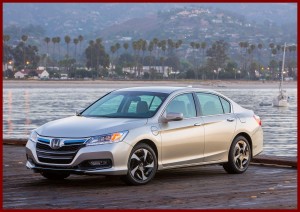
This is a comeback effort at Honda, a company that was once heralded for its efficiency and quality.
When it goes on sale in early 2013, the new Accord plug-in hybrid – PHEV – will use Honda’s first two-motor hybrid system along with a 2-liter 4-cylinder engine producing 137 horsepower. The total system output is 196 horsepower. This is more than the Toyota Prius Plug-In Hybrid, Chevrolet Volt and the projected output of the Ford Fusion Energi plug-in hybrid – so I guess a horsepower war of sorts is now underway in what are supposed to be fuel efficient vehicles.
Since electric driving depends on a tiny 6.7 kilowatt-hour (kWh) lithium-ion battery, this means the Accord PHEV will be hard pressed to stay on electricity for more than 10 or 15 miles, although it will look good on the window sticker with a projected EPA rating of greater than 100 MPGe. The electric motors are rated at 124-kilowatt (kW). Thank goodness there is also power dense gasoline on board, so the projected range of the plug-in is almost 500 miles.
Honda also predicts it will receive an Enhanced AT-PZEV rating from the California Air Resources Board, which is now on its second attempt to force demand for EVs on the left coast after a spectacular and costly failure at the end of the last century. Most important for initial sales in this century, the Accord plug-in will qualify for access to restricted HOV (high occupancy vehicle) lanes even when driven solo as most of them likely will be.
The Accord Plug-in Hybrid Sedan will use one of four new powertrains for what remains in the U.S. a best selling car, even though the current Accord with its 5-speed transmission is badly lagging in the fuel economy rating wars. The Accord Plug-in will also serve as the platform for a conventional hybrid version of the Accord Sedan, which will join the line in the summer of 2013.
Here, Honda although it arguably pioneered hybrid technology, will try yet again to put a nick in the ongoing market dominance of the Toyota. If you are keeping score, year-to-date the Civic Hybrid and Acura ILX have sold 5,600 vehicles. This compares to sales of Toyota and Lexus hybrids of 28,960 hybrid vehicles in the month of August alone. (Toyota 25,400 hybrids. Lexus 3,560 hybrids for the month of August.)
Beyond its frankly laughable range as a full-electric vehicle, owners of the 2014 Accord PHEV will be able to choose two additional driving modes to manage limited battery capacity for their own commute. In its default upon start-up, the Accord PHEV acts as a pure electric vehicle and will continue in full-electric mode until battery capacity drops and an automatic switch is made to gasoline and electric hybrid operation. At higher speeds or under high demand for acceleration, the gasoline engine will provide additional power.
In “HV” mode, the plug-in Accord acts as a conventional hybrid, combining power between the gasoline engine and electric motors to maximize fuel efficiency while maintaining the battery charge level. In “HV Charge” mode, the Accord PHEV blends gasoline and electric power while also augmenting the battery charge level.
The Accord Plug-In will also have an electric servo braking system similar to the one used on the Honda Fit EV, that is claimed to allow for exceptionally natural brake pedal feel (hah!), while extending the range where regenerative braking can work. The plug-in Accord can be fully charged from its low-charge warning point in less than three hours using a standard 120-volt household electrical outlet, and in less than one hour using an expensive 240-volt “Level-2” charger. A free HondaLink EV smartphone application will allow owners to monitor the charging state.
Honda engineers pursued weight reduction, aerodynamic efficiency and low rolling resistance in the Accord PHEV to maximize driving range from every scarce watt of electrical energy and every gallon of gasoline. Weight reduction features include:
- All-aluminum front subframe
- 17-inch forged aluminum wheels
- Aluminum brake pedal
- Aluminum hood
- Aluminum rear bumper beam
- Puncture repair kit (in place of gasoline-engine Accord’s spare wheel and tire)
Aerodynamic advancements include:
- Powertrain undercover
- Cabin floor undercovers
- Rear decklid spoiler
- Aerodynamic wheel covers
Reductions in rolling resistance include:
- Low rolling-resistance tires
- Low-friction wheel bearings
So this is a serious comeback effort from what was once a company noted for its efficiency. The difference this time around is that virtually every automaker is pursuing the same technologies in a quest for the same goal – the most efficient car in its given class.
The ninth generation Accord, a perennial top seller in the family car category faces unprecedented competition from the Toyota Camry – the best selling car in the U.S. and all new last year – a revised Nissan Altima, and the Hyundai Sonata, as well as the Ford Fusion and Chevrolet Malibu, among others. The category is important for its size – almost 20% of the cars sold in the U.S., and as a result, its bragging rights. And the biggest competitor here might be the newly efficient 2013 Accord when its price and fuel economy ratings are finalized. Stay tuned.
See: Reality Versus Concept as Production Accord Photos Released

